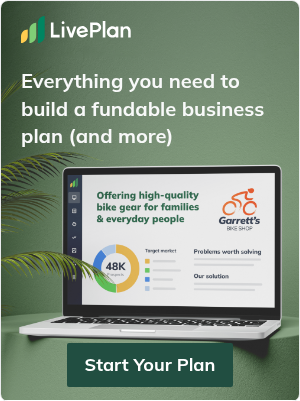How To Create a Business Plan for a Bank Loan [4 Key Steps]

Jump to
Wondering how to create a business plan that will wow your banker?
You’re not alone.
Aside from your loan application, your business plan is the main supporting document to help you get a business loan. Getting all the details just right is absolutely essential.
So here’s what we recommend: simplify the planning process by breaking the work up into manageable, bite–sized steps. That way, you can focus on one section at a time to ensure that your business plan is accurate and convincing.
Here’s a quick overview of the step–by–step process we guide entrepreneurs through when they sign up for LivePlan.
1. Outline the opportunity
This is the core of your business plan. It should give loan officers a clear understanding of:
What problem you’re solving How your product or service fits into the current market What sets your business apart from the competition
There are three key parts to this step:
The problem and your solution
Detail exactly what problem you are solving for your customers. How do their lives improve after you solve that “pain point” for them?
Be sure to describe your solution in vivid detail. For example, if the problem is that parking downtown is expensive and hard to find, your solution might be a bike rental service with designated pickup and dropoff locations.
If you’re just starting, we recommend actually going out and talking with your customers first. That way, you can prove you’re solving a real problem for your intended audience.
Target market
Who exactly are you selling to? And roughly how many of them are there?
This is crucial information for determining whether or not your business will succeed long–term. Never assume that your target market is “everyone.” You need to break down the total market into a realistic number of sales based on your business’s capabilities.
For example, it would be easy for a barber shop to target everyone who needs a haircut. But most likely, it will need to focus on a specific market segment to reach its full business potential. This might include catering to children and families, seniors, or business professionals.
Competition
Who are your direct competitors? These are companies that provide similar solutions that aim to solve your customers’ pain points.
Then outline what your competitive advantages are. Why should your target market choose you over other products or services?
Do you think you have no competition? Think again. Your customers are likely turning to an indirect competitor who is solving their problem with a different type of solution.
For example, a taco stand might compete directly with another taco stand but indirectly with a nearby hot dog vendor.
2. Show how you’ll execute
This is where the action happens!
Here you’ll get into the details of how you’ll take advantage of the opportunity you outlined in the previous section. This part demonstrates to banks that you have a strong plan to achieve success.
The three main components of this step include:
Marketing and sales plan
There can be a lot of moving parts to this one, depending on your business model.
But most importantly, you’ll need to fully explain how you plan to reach your target market and convert those people into customers.
Here are a few examples of what to include:
Positioning strategy: What makes your business both unique and highly desirable to your target market? Marketing activities: Will you advertise with billboards, online ads or something else entirely? Pricing: The price you charge must reflect consumer demand. There are several pricing models to choose from, including ‘cost–plus pricing’ and ‘value pricing.’
Operations
This is the nuts and bolts of your business. It’s especially important for brick–and–mortar companies that operate a storefront or have a warehouse. You may want to explain why your location is important or how much space you have available.
Plan to work at home? You can also cover your office space, how this positively impacts your expenses, and if you have any plans to move outside your house.
If you use any specialized software, equipment, or tools be sure to mention them here as well.
Milestones and metrics
Lenders and investors want to be confident that you know how to turn your business plans into financial success. That’s where your milestones come in.
These are planned goals that help you progress your company. For example, if you’re launching a new product your milestones may include completing prototypes and figuring out manufacturing.
Metrics are how you will gauge the success of your business.
Do you want to generate a certain level of sales? Or keep costs at a certain level? Figuring out which metrics are most important and then tracking them is essential for growth.
3. Detail your financial plan
This is the most crucial – and intimidating – part of any business plan for a bank loan.
Your prospective lender will look especially close at your financial performance and financial forecasts to determine how likely your business is to succeed.
Ideally, you’re already tracking your finances and have at least dabbled with forecasting. However, if you’re starting from scratch, break your financial planning into the following smaller pieces:
Forecasts
Simply put, these are your projections for your business finances. It gives you (and the bank) an idea of how much profit your company stands to make. Just a few items you’ll need to include:
Sales forecast: List all your products, services, and any other ways your business will generate revenue. If you have direct costs, or expenses required to make what you sell, consider adding them as a percentage of your revenue. Personnel forecast: Salaries and expenses related to what you pay yourself, employees, and any contractors. Expense forecast: Things like rent, utilities, marketing costs, and any other regular expenses.
Financing
How much and how will you use any investments, loans, or other financing to grow your business? This might include paying for capital expenses like equipment or hiring personnel.
Explain where the money will go, and if possible, create a forecast scenario showing the use and repayment of the loan. Also detail where all your financing is coming from. Lines of credit, loans, or personal savings should be listed here alongside the loan you’re applying for.
Statements
Bankers will be giving this section a lot of attention. Here’s what you’ll need:
Profit & Loss: This statement pulls in numbers from your sales forecast and other elements to show whether you’re making or losing money. Balance Sheet: This is likely the first thing a loan officer will look at. It covers your liability, capital, and assets and provides an overview of your business’s financial soundness. Cash Flow Statement: Essentially, this statement tracks how much money you have in the bank at any given point. Loan officers will likely expect realistic monthly cash flow for at least 12 months.
4. Summarize your business information
The executive summary is the first section of your business plan, but we recommend you tackle it last.
It’s an introduction to your company and summarizes the main points of your plan. While lenders will need to review your full business plan, they may use the executive summary as a quick way to determine whether your business is worth their time.
It may be your only chance to get the lender excited about your business. So, keep it to just one or two pages and be as clear and concise as possible.
What to check before submitting your business plan to the bank
Before you finish your loan application and send in all your paperwork, be sure to review the following in your business plan:
Did you complete every section? Business plans have a fairly standard outline that lenders expect to see. It might sound simple, but make sure that you don’t leave a section blank by mistake. If you want to verify that everything is correct, consider using a business plan builder that uses an investor-approved outline. Have you completed your full financial plan? Having detailed financials is expected. Your historical performance and financial forecasts tell the story of your growth path through numbers. Be sure that all of your financial documents are included and accurate. To go above and beyond, be sure to include the assumptions behind your financials and any financial scenarios you’ve been exploring. Is your plan concise? No one has time to read a 50-page business plan, and you probably don’t want to write one. Keep every section of your business plan to-the-point, and be sure to populate your executive summary. If something should be included but adds unnecessary complexity to your plan, go ahead and add it to your appendix. Did you pay attention to spelling, grammar, and punctuation? Small things really do make a difference, so dot those i’s and cross those t’s. If you can, have someone else review your business plan to catch any errors you may have missed. For another review, consider using an AI business plan generator to check your grammar and even rewrite sections to sound more professional. Is your plan realistic? Make sure your calculations, goals, and predictions are practical, and that you back-up your plan with good market research. Also, double-check that sections of your business plan don’t contradict one another.
If you need help writing your plan
Getting a business loan isn’t easy. According to Federal Reserve Data, only 31% of businesses receive the total amount of financing they request.
Having a well-written business plan for your bank loan can go a long way toward you being among the businesses that do get the funding they ask for.
Not everyone feels confident writing a business plan themselves, especially if it’s needed to secure a bank loan. While you don’t need an MBA to write one, getting your business plan right often does require quite a bit of work.
So if you need help writing your plan, here are a few options to consider:
Download a free business plan template: Start with an expert-designed template formatted to meet lender expectations.
Check out our guide on writing a detailed business plan: Dig deeper into what to include in every section of your business plan.
Hire a professional business plan writer to do it for you: This is typically the most expensive route, but worth it if you’re pursuing $100,000 or more in capital.
Sign up for LivePlan: It’s business planning software that provides a step–by–step process for writing any type of plan. It’s an affordable option that also gives you an easy way to track your actuals against your business plan, so you can get the insights you need to grow faster.
More in Funding
funding
Where to Get Feedback on Your Business Pitch in 2025

funding
10 Reasons You Don’t Qualify for an SBA Disaster Loan
funding
How to Correctly Use Collateral to Secure a Business Loan
funding









